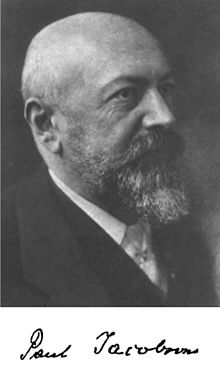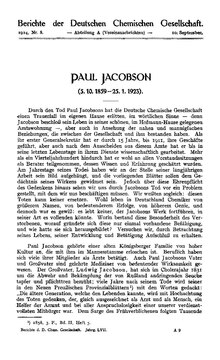Paul Jacobson
Paul (Heinrich) Jacobson (born October 5, 1859 in Königsberg , † January 25, 1923 in Berlin ) was a German chemist . He worked on azo and hydrazo compounds as well as mercaptans and semidines .
Life
Paul Jacobson's father was the Berlin medicine professor Heinrich Jacobson (1826–1890). His brother, Louis Jacobson (1852–1905) became an ear specialist and professor of otology .
Paul Jacobson studied chemistry from 1877 at the University of Heidelberg and from 1880 at the Technical University of Berlin (at that time the industrial academy) with Carl Liebermann in the organic laboratory. After graduating as a Dr. phil. After receiving his doctorate, he became a teaching assistant at the trade academy in Berlin and in 1885 a chemist at Kunheim & Co. in Berlin ( Niederschöneweide ).
In 1886 he went to the University of Göttingen to Victor Meyer , where he completed his habilitation the following year. In 1889 he became a private lecturer and in 1891 an associate professor for pharmaceutical chemistry in Heidelberg . In 1892 he discovered what he called the semidine rearrangement (cf. benzidine rearrangement ). He also dealt with sulfur-containing heterocycles, such as the naphthalene analogues (i.e. with two rings) of the thiophene discovered by Victor Meyer .
In 1896 Jacobson became general secretary of the German Chemical Society (DChG) and published their reports from 1897 onwards. From 1900 to 1906 he edited five supplementary volumes to Beilstein's Handbook of Organic Chemistry , for which he was commissioned by the DChG in 1896. In 1911 he gave up the post of general secretary of the DChG and became scientific director of the department for chemical collective literature of the German Chemical Society. He prepared the 4th edition of the Beilstein with Bernhard Prager (the "main work" ) with the Beilstein system still used today . In 1919 he put the publication down, but continued to work on the Beilstein. Even before that, he found less and less time for Beilstein due to other workloads, whose publishing activity from 1907 (the completion of the supplementary volumes of the 3rd edition) was at Prager, which he had brought to the Beilstein editorial team in 1899.
With Victor Meyer he wrote the multi-volume textbook on organic chemistry , which appeared from 1891 and was supervised by him alone after Meyer’s death in 1897.
In 1921 he became associate professor for chemistry at the University of Berlin.
Individual evidence
- ↑ aminodiphenyls
- ↑ Short biography of the father
literature
- Hans Richter: Jacobson, Paul. In: New German Biography (NDB). Volume 10, Duncker & Humblot, Berlin 1974, ISBN 3-428-00191-5 , p. 247 ( digitized version ).
- Entry in Winfried Pötsch, Annelore Fischer, Wolfgang Müller: Lexicon of important chemists, Harri Deutsch 1989
| personal data | |
|---|---|
| SURNAME | Jacobson, Paul |
| ALTERNATIVE NAMES | Jacobson, Paul Heinrich |
| BRIEF DESCRIPTION | German chemist |
| DATE OF BIRTH | October 5, 1859 |
| PLACE OF BIRTH | Königsberg , Province of Prussia , Kingdom of Prussia |
| DATE OF DEATH | January 25, 1923 |
| Place of death | Berlin , Free State of Prussia , Weimar Republic |

